You can reduce your home’s heating and cooling costs through proper insulation and weatherization (air sealing) techniques. Any air sealing efforts will complement your insulation efforts, and vice versa. These techniques will also make your home more comfortable.
Insulation
You need insulation in your home to provide resistance to heat flow. The more heat flow resistance your insulation provides, the lower your heating and cooling costs will be. How much money you save will depend on present insulation levels and how much you add to them.
Heat flows naturally from warmer to cooler spaces. In the winter, this heat flow moves directly from all heated living spaces to adjacent, unheated attics, garages, basements and even to the outdoors. Heat flow can also move indirectly through interior ceilings, walls and floors — wherever there is a difference in temperature. When the weather is warmer, heat flows from the outdoors to the interior of a house.
To maintain a comfortable temperature, the heat lost in winter must be replaced by a heating system. By the same principle, the heat gained in the summer must be removed by a cooling system. Properly insulate your home for decreased heat flow and effective heat flow resistance.
For good energy efficiency, your home should be properly insulated from roof to foundation. This includes the following areas:
- Spaces such as access doors to unfinished attics or knee walls in finished attics
- Ducts in unconditioned spaces
- Cathedral ceilings
- Exterior walls
- Floors above unheated garages
- Foundations: basements, crawl spaces, slab-on-grade floors
Several areas are often neglected in the process of insulating a home, including:
- Walls separating living areas from an attached garage
- Basement garage walls and ceiling
- Dormer walls and ceiling
- Sloping ceiling areas in upstairs rooms where the ceiling has been clipped to accommodate rafters
- Narrow cracks around window and door frames
R-value
Insulation’s resistance to heat flow is measured in terms of its thermal resistance, or R-value. The R-value is additive, meaning 2 inches of a given material will have twice the R-value of 1 inch. Also, the individual R-values for all materials in a section of a structure, such as in a roof, wall or crawl space, can be added together to obtain a total R-value.
Several years ago, most insulation material was mineral wool or fiberglass. These materials have similar insulating properties, and it was common practice to specify insulation in terms of inches of thickness. Today, there are many different insulation materials on the market, and each has an R-value per inch of thickness. The only way to compare their insulating ability is to compare their R-values.
Recommended R-values for Missouri homes
For most Missouri homes, the following are R-value recommendations for various areas:
- Ceilings and attics: 49
- Walls: 18
- Floor over crawl space: 25
- Crawl space wall: 19
- Slab edge: 8
- Basement wall: 11
Types of insulation
There are many options to choose from when it comes to insulating your home. The best type for your needs will depend on where you plan to install insulation and the recommended R-values for the target areas. Table 1 describes the most common insulation types, as well as useful information on how and where they should be installed.
Table 2 provides an overview of the range of R-values for most of the common home insulation types.
Table 1
Common types of home insulation
| Type | Insulation materials | Location | Installation method(s) |
|---|---|---|---|
| Loose-fill | Cellulose Fiberglass Mineral |
Existing, enclosed wall or new, open wall cavities; unfinished attic floors and hard-to-reach places | Blown into place using special equipment |
| Blankets: batts and rolls | Fiberglass Mineral wool |
Unfinished walls, foundation walls, floors and ceilings | Fitted between studs, joists and beams |
| Foam board or rigid foam | Polystyrene Polyisocyanurate Polyurethane |
Unfinished walls, foundation walls, floors, ceilings and unvented low-slope roofs | Must be covered with ½-inch gypsum board on interior side for fire safety and weatherproof facing on exterior side |
| Sprayed foam and foamed-in- place | Cementitious Icynene Phenolic Polyisocyanurate Polyurethane |
Existing, enclosed wall or new, open wall cavities; unfinished attic floors | Applied using small spray containers or in larger quantities as a pressure-sprayed product (foamed-in-place) |
Table 2
R-values (per inch thickness) for common types of home insulation
| Insulation type | R-value |
|---|---|
| Fiberglass blanket or batt | 2.9 – 3.8 |
| High-performance fiberglass blanket or batt | 3.7 – 4.3 |
| Loose-fill fiberglass | 2.3 – 2.7 |
| Loose-fill rock wool | 2.7 – 3.0 |
| Loose-fill cellulose | 3.4 – 3.7 |
| Perlite or vermiculite | 2.4 – 3.7 |
| Expanded polystyrene board | 3.6 – 4 |
| Extruded polystyrene board | 4.5 – 5 |
| Polyisocyanurate board, unfaced | 5.6 – 6.3 |
| Polyisocyanurate board, foil-faced | 7 |
| Icynene | 3.7 |
| Spray polyurethane foam | 5.6 – 6.3 |
Vapor barriers
One problem associated with adding insulation in the home is condensation, or moisture. All air contains moisture, and warm air can hold more moisture than cold air. Air inside the house is warmer than outside during winter months, and normal household activities — such as washing, cooking and bathing — continually add moisture to the air.
Water vapor in air behaves like heat, moving from areas of high concentration inside the house to areas of low concentration outside the house. If it encounters a cold surface along the way, it will condense into free water. When condensation occurs inside an insulated wall, insulation becomes wet. This can lead to the decay of building materials, stained finishes and can cause paint to begin peeling. In conjunction with insulation, a vapor barrier material can prevent such moisture buildup.
A vapor barrier, or vapor diffusion retarder, is a material that reduces the rate at which water vapor can move through a material. Effective moisture control throughout a home includes air-sealing gaps in the home in addition to the use of a vapor diffusion retarder. Vapor barriers are installed over the face of the studs or joists on the side closest to the inside surface of the home. The vapor barrier prevents moisture in the form of water vapor from reaching cold surfaces where it can condense.
Adding insulation
To determine whether you should add insulation, you first need to find out how much insulation you already have in your home and where. A qualified home energy auditor or home inspector will conduct an insulation check as part of a routine whole-house energy audit. An energy audit will also help identify areas of your home that are in need of air-sealing. If you don’t want an energy audit, you need to determine
- What type of insulation you have, and
- The R-value and the thickness of the existing insulation.
If you live in a newer house, you can probably get this information from the builder. If you live in an older house, you may need to inspect the insulation yourself. Check the attic, walls and floors adjacent to an unheated space, such as a garage or basement. The structural elements are usually exposed in these areas, which makes it easy to see what type of insulation you have and measure its thickness.
Alternatively, you can inspect the insulation in exterior walls and ceilings at an electrical outlet or light fixture by following these steps:
- Turn off the power to the outlet or light fixture from the circuit breaker panel or fuse box.
- Remove the outlet cover or light fixture and shine a flashlight into the crack around it. You should be able to see if there is insulation in the wall or ceiling, and possibly how thick it is.
- Remove a small amount of insulation if needed to help determine its type.
- Check outlets and light fixtures on the first and upper floors, if any, and in old and new parts of a house. Just because there is insulation in one area doesn’t mean it’s everywhere in the house.
Inspect and measure the thickness of any insulation in unfinished basement ceilings and walls, or above crawl spaces. If the crawl space isn’t ventilated, it may have insulation in the perimeter wall. If your house is relatively new, it may have been built with insulation outside the basement or foundation walls. If so, the insulation in these spaces won’t be visible. The builder or the original homeowner might be able to tell you if exterior insulation was used.
Attic areas are easily accessible in most homes. This means labor costs for installing additional insulation will be at a minimum. You may even be able to do it yourself. The ceiling is the often the biggest source of heat loss because it usually represents the largest area exposed to outside temperatures.
Uninsulated floors over unheated basements or crawl spaces lose about half as much heat as is lost through the ceiling area of the house. Pay special attention to water lines and other plumbing when installing floor insulation. Belowground basements rarely freeze, but crawl spaces and walkout basements may occasionally be subjected to freezing temperatures if the floors above are insulated. You can prevent this by insulating pipes or by sufficiently heating the area to keep it above freezing. In either case, an insulated floor will result in more comfortable floors and a net savings on your energy bill.
Homes built on concrete slabs and those with walkout basements should have perimeter slab insulation. If no insulating barrier exists between the concrete slab and the exterior of the house, you lose a considerable amount of heat and will have uncomfortably cool floors near the edge of the slab.
Unless you are planning to do extensive remodeling, you will find adding insulation to an existing wall quite difficult. If you have any wall insulation at all, it’s practically impossible to add to it without removing either the inside or outside wall covering material. Walls with no insulation at all can have fill-type insulation added to the spaces between studs, but this will have to be done professionally (Figure 1). It involves drilling holes in exterior walls between each stud and filling the empty space full of insulating material. The fill holes are then capped or plugged. In some cases, it is possible to remove one or more strips of exterior siding before drilling holes. The siding can then be replaced, covering the holes.
Piping and ducts should be on the interior wall, ceiling or floor side of the insulation for maximum energy efficiency. If water pipes are on the exterior side of the insulation, they are more susceptible to freezing. If piping cannot be located on the interior side of the insulation, special pipe insulation should be installed to keep the pipes from freezing and to improve energy efficiency. Pipe insulation is available in precut foam tubes in a range of sizes and in fiberglass batts that can be wrapped around each pipe.
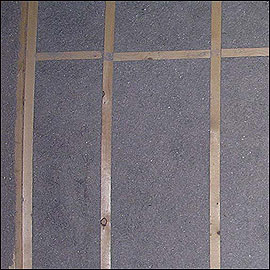 Figure 1
Figure 1
Blown-in cellulose insulation between wall studs.
Ventilating the attic and crawl space
During the summer, excess heat that builds up in the attic and crawl spaces during the day results in high energy costs for cooling. Also, moisture produced within the home may move into these areas without vapor barriers in place to stop it. If this moisture is not exhausted from the attic or crawl space, it can condense and cause deterioration of insulation and construction materials.
In Missouri homes, there should be 1 square foot of ventilation for every 300 square feet of attic or crawl space.
Proper attic ventilation systems allow a continuous flow of outside air through the attic. It consists of a balance between air intake at your eaves or soffits and air exhaust at or near your roof ridge (Figure 2). Soffit vents come in several sizes and styles, including small round discs and rectangular grilles. Perforated soffit material provides ventilation at the lowest part of a roof. Ventilated roof ridge shingles, ridge vents, gable end vents, static vents or roof turbines can provide adequate ventilation at the highest part of the roof. Many roofs have special baffles installed to keep attic insulation from blocking eave or soffit vents.
For crawl spaces, these vents are usually square or rectangular and are specifically designed for concrete or masonry foundation walls. They should be spaced equally along the crawl space wall perimeter. Make sure that the floor above the crawl space is well insulated, otherwise venting the crawl space will actually increase your energy use and could cause pipes to freeze.
Fan-driven ventilators are powered by electricity and usually controlled by a thermostat in the attic or crawl space. They are effective, but because they are motor-driven, the extra cost of running them partially offsets the energy they conserve.
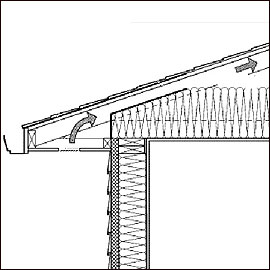 Figure 2
Figure 2
Cross section of roof and wall showing insulation and attic ventilation.
Weatherization
Air leakage, or infiltration, occurs when outside air enters a house uncontrollably through cracks and openings. Properly air-sealing such cracks and openings in your home can significantly reduce heating and cooling costs, improve building durability, and create a healthier indoor environment.
The average house, even when well-insulated, contains cracks and gaps between building materials that add up to a hole about 14 inches square. In winter, those gaps may make the house drafty and chilly. All year, a leaky house not only wastes energy, but can also lead to water damage and provide an entryway for insects. Air infiltration can also contribute to problems with moisture control. Leaks in areas such as the attic or foundation can allow moldy or dusty air to enter the house, which could cause health problems.
The recommended strategy in both new and old homes is to minimize air leakage as much as possible. Weatherization includes sealing all exterior openings and cracks with sealant and installing weatherstripping to all operable windows and doors.
Detecting air leaks
Drafts or cold spots may indicate some of the larger air leakage spots in your home, but you’ll need to find the less obvious gaps to properly air-seal your home. A complete energy audit can also help determine areas in your home that need more insulation. For a thorough and accurate measurement of air leakage in your home, you should complete an energy audit or consult a qualified energy auditor or technician to conduct one for you. In most areas of Missouri, these audits are free and are provided by utility companies, state agencies or a University of Missouri Extension office.
In some cases, an energy auditor can locate hard-to-find gaps and areas of energy loss with a blower door test or thermographic scan. Thermographic scanning uses an infrared camera to detect air and heat leakage in the exterior surfaces of your house.
Without these tests, there are ways to find some air leaks yourself. First, look at areas where different materials meet, such as between brick and wood siding, between foundation and walls, and between the chimney and siding. Also inspect the following areas for any cracks and gaps that could cause air leaks:
- Door and window frames
- Mail chutes
- Electrical and gas lines
- Television and phone lines
- Outdoor water spigots
- Dryer vent wall connections
- Bricks, siding, stucco and foundation
- Air conditioners
- Vents and fans
You can also use the following methods to detect air leaks in your home:
- At night, shine a flashlight over potential gaps while a partner observes the house from outside. Large cracks will show up as rays of light.
- Shut a door or window on a piece of paper. If you can pull the paper out without tearing it, you’re losing energy.
Sealing and caulking
Sealant and caulk form flexible seals for cracks, gaps or joints less than ¼ inch wide. You can use a sealant or caulking compound to seal air leaks in a variety of places throughout your home, including around windows and door frames. Caulk and seal air leaks where plumbing, ducting or electrical wiring penetrates through exterior walls, floors, ceilings and soffits over cabinets. In addition to sealing air leaks, caulking can also prevent water damage inside and outside the home.
Most caulking compounds come in disposable cartridges that fit in half-barrel caulking guns. If possible, purchase one with an automatic release. Some pressurized cartridges do not require caulking guns. When deciding how much to purchase, consider that you’ll probably need a half-cartridge per window or door and four cartridges for the foundation sill. Caulking compounds are also sold in aerosol cans, squeeze tubes and ropes (Figure 3) — sometimes called rope caulk — for small jobs or special applications.
Caulking compounds vary in strength, composition and price. Water-based caulk can be cleaned with water, while solvent-based compounds require a solvent for cleanup. Table 3 summarizes the options for various available sealants.
Installing sealants can be tricky and messy. Follow the instructions on the compound cartridge, and save yourself some trouble by remembering these helpful tips:
- For good adhesion, clean all areas to be caulked. Remove any old caulk or paint using a putty knife or a flathead screwdriver. Make sure the area is dry so you won’t seal in moisture.
- Hold the gun at a consistent angle; 45 degrees is ideal for getting deep into the crack. You know you’ve got the correct angle when the caulk is immediately forced into the crack as it comes out of the tube.
- Caulk in one straight, continuous stream, if possible. Avoid stops and starts.
- Send caulk to the bottom of an opening to avoid bubbles.
- Make sure the caulk sticks to both sides of a crack or seam.
- Release the trigger before pulling the gun away to avoid applying too much caulking compound. A caulking gun with an automatic release makes this much easier.
- If caulk oozes out of a crack, use a putty knife to push it back in.
- Don’t skimp. If the caulk shrinks, reapply it to form a smooth bead that will seal the crack completely
The best time to apply caulk is during dry weather when the outdoor temperature is above 45 degrees. Low humidity is important during application to prevent cracks from swelling with moisture. Warm temperatures are also necessary so the caulk will set properly and adhere to the surface.
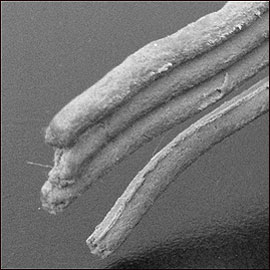 Figure 3
Figure 3
Rope caulk.
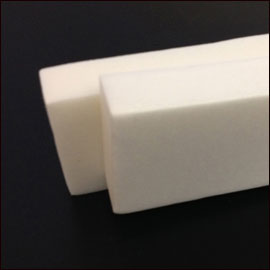 Figure 4
Figure 4
Foam tape.
Table 3
Sealant and caulking types
| Compound | Cleanup | Shrinkage | Adhesion | Cost | Comments |
|---|---|---|---|---|---|
| Silicone | Dry cloth if immediate or mineral spirits | Little or none | Good to excellent | High | Permits joints to stretch or compress. Will stick to painted surfaces, but paint will not adhere to most cured silicone. |
| Polyurethane expandable spray foam | Solvent such as lacquer thinner, if immediate | None; expands quite a bit | Good to excellent | Moderate to high | Spray-foam quickly expands to fit larger, irregular-shaped gaps. Flexible. Can be applied at variable temperatures. Must be painted for exterior use to protect from ultraviolet radiation. |
| Water-based foam sealant | Water | None; expands only 25 percent | Good to excellent | High | Takes 24 hours to cure. Cures to soft consistency. Water-based foam production does not produce greenhouse gases. Will not over-expand to bend windows (new construction). Must be exposed to air to dry. Not useful for larger gaps, as curing becomes difficult. |
| Butyl rubber | Mineral spirits | From 5 to 30 percent | Good | Moderate to high | Durable 10 or more years; resilient, not brittle. Can be painted after curing one week. Variable shrinkage; may require two applications. Does not adhere well to painted surfaces. Toxic; follow label precautions. |
| Latex | Water | From 5 to 10 percent | Good to excellent | Moderate | Easy to use. Seams can be trimmed or smoothed with moist finger or tool. Water resistant when dry. Can be sanded and painted. Less elastic than above materials. Varied durability, 2 to 10 years. Will not adhere to metal. Little flexibility once cured. Needs to be painted when used on exteriors. |
| Oil or resin- based | Mineral spirits | From 10 to 20 percent | Good | Low | Readily available. Least expensive of the four types. Rope and tube forms available. Oils dry out and cause material to harden and fall out. Low durability, one to four years. Poor adhesion to porous surfaces like masonry. Should be painted. Can be toxic (check label). Limited temperature range. |
| Polyurethane | Dry cloth if immediate or mineral spirits | Little or none | Good to excellent | High | Permits joints to stretch or compress. Will stick to painted surfaces and paint will usually adhere to most cured urethanes. |
Weatherstripping doors and windows
Weatherstripping around windows and doors is essential to stopping air infiltration (Figure 5). Doors and windows in new homes generally come with factory-installed weatherstripping. However, doors and windows in homes that are 10 years or older may not have any weatherstripping at all.
There are four main categories of weatherstripping:
- Compression foam, gaskets or bulbs: Compression weatherstripping is used to seal swinging doors and window sashes. It consists of a molded strip (it may be wood, aluminum or rigid vinyl) with a flexible vinyl or rubber bulb along one side. As a rule, this type is the most durable. It is available as either a self-adhesive or nail-on product.
- V-type strips and tape: V-shaped weatherstripping is fitted against the side of the door or window jamb so it presses against the edge of the door or window sash to form a seal. V-type stripping may be vinyl, plastic or metal. It is available as either a self-adhesive or nail-on product.
- Foam and foam tape: Foam weatherstripping is used to seal swinging or sliding doors or windows. It comes in various sizes with an adhesive backing on one side. It is usually a self-adhesive product fastened to the edge of a door or window stop, or to the bottom of a sliding window sash. In some cases, it can also be used to seal other air gaps in walls and floors where caulk or sealant is typically used.
- Thresholds and door bottoms: A threshold fills the gap between the floor and the bottom of a door. It may have a built-in vinyl bulb. It should be paired with a door bottom or sweep mounted on the lower edge of the door. These products are typically installed with small nails or screws usually included with the purchase of the weatherstripping.
When using any form of pressure-sensitive or stick-on weatherstripping, you must clean the door and window surfaces. A rag dampened with fast-drying lacquer thinner or alcohol will suffice to clean the area. Many of the self-adhesive weatherstripping products can be cut to size using a carpet knife or heavy scissors. Some kits are also available in precut sizes for common door and window dimensions.
Installation of nail-on weatherstripping requires the use of a hammer, small finishing nails and a small saw or tin-snips to cut the product to fit the door or window. Some nail-on products are also available in precut sizes for common standard door and window dimensions.
Door bottom weatherstripping is available in several materials. While easy to apply, these products can interfere with door swing and require a reasonably level threshold beneath the door. Simple hand tools are required to install any of these door bottoms. After cutting it to size with a hacksaw or tin snips, the door bottom is surface mounted to the inside of the door using wood screws, which are normally provided by the manufacturer. An alternative variety of door bottom weatherstripping is available for the mechanically operated, automatic door bottom. In this model, a vinyl bulb automatically lowers against the floor when the door is shut and retracts when the door is opened.
Common thresholds are available in aluminum, bronze or brass with a flexible vinyl or rubber bulb. When new, this threshold is effective, but the bulb soon collapses under continual use, leaving a sizable crack beneath the door. In many products, the bulb insert is replaceable. Though not the easiest to install for the do-it-yourself homeowner, the combination door bottom and threshold is long-lasting and provides effective protection against air infiltration. Because the vinyl is mounted in an aluminum extrusion fastened to the door, the aluminum threshold bears the brunt of wear.
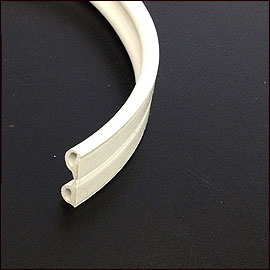 Figure 5
Figure 5
Weatherstripping.
Installing door and window weatherstripping
To install weatherstripping on a door, first install the threshold. Measure the distance from the floor to the bottom edge of the door; thresholds come in a number of typical heights varying from 5/8 to 1 inch. Choose a threshold that allows about a ½-inch gap to leave room for the bulb.
The threshold should be placed so its highest point or the bulb center is directly under the door. Measure the width of the opening and cut the threshold to length with a saw. The threshold will probably have to be notched on each end so it fits around the doorstops.
Set the threshold in place and close the door to check the fit and position. Once the threshold is in place, mark its location on the floor, then open the door. Run a thin bead of caulk along the underside of the threshold on each side. Some thresholds have a C-shaped channel along the edges to accept caulk. Set the threshold in place and screw it firmly to the floor.
To apply nail-on compression weatherstripping to a door or swinging — but not sliding — window, first close the door or window. If the door has a deadbolt, lock it. Cut each strip to length with a saw or tin snips and stand it in place. Push the strip in toward the door or window sash so the bulb is partially compressed. Don’t fit it too tightly or the door or window won’t close properly. Nail the strip in place, starting from the center and working your way toward both ends. Check the door or window frequently to make sure it operates easily.
To apply self-adhesive foam weatherstripping, cut the foam strips to length with scissors. Peel back about 1 inch of the adhesive cover strip and press the foam into place at the top of the door or window stop. Work your way down, peeling the cover strip away as you press the foam into place.
To apply V-type weatherstripping to a door or swinging window, cut the strips to length with scissors (for vinyl or plastic strips only), tin snips or a hacksaw. Place each strip on the jamb with the raised “V” facing away from the door or window sash, positioned so the door or window sash will be centered on the strip when closed. Fasten the strips in place.
To apply V-type weatherstripping to a double-hung window, first lower the sash. Cut the strip to length and slip it down along the side of the sash with the raised “V” facing outside. Position the strip in the center of the sash and fasten it in place as far as possible. Raise the sash and repeat the process along the lower half of the strip.
Other air sealing ideas
Many hardware stores and lumberyards carry special precut foam or rubber inserts to seal gaps and air leaks around electrical outlets and light switches on the interior side of exterior walls. These inserts are easier to install and less hassle than trying to use caulk or sealant.
When the fireplace is not in use, keep the flue damper tightly closed. A chimney is designed specifically for smoke to escape, so air will continue to escape until you close it.
Window air conditioning units are common areas for significant air leakage. To eliminate infiltration around your window unit, caulk and seal all exterior sash and window joints, especially where the windowpane touches the air conditioner unit. When autumn arrives, wrap the unit with a prefabricated air conditioner cover, or make your own using 4 mil polyethylene plastic sheeting. Tape the plastic to the window casing around the entire perimeter of the unit. To slow air infiltration from the crack between the raised sash of a double-hung window and the air conditioner, use ordinary fiberglass insulation or urethane foam strips. Many hardware and home products stores have special kits for installation around window air conditioner units.
Additional information
MU Extension publishes a series of guides on energy efficiency in the home, on the farm and alternative energy. Ask your local MU Extension office about the E3A curriculum about classes and programming to learn more.
The following websites are also good resources for additional information on insulating and weatherizing new and existing homes:
- http://missourifamilies.org/
- http://www.energystar.gov
- http://www.eere.energy.gov
- http://www.doe.gov
- http://www.nrel.gov
- http://www.aceee.org
References
- U.S. Department of Energy. Home Weatherization. http://energy.gov/public-services/homes/home-weatherization
- U.S. Environmental Protection Agency. A Do-It-Yourself Guide to Sealing and Insulating with Energy Star: Sealing Air Leaks and Adding Insulation. 2008. http://www.energystar.gov/ia/partners/publications/pubdocs/DIY_Guide_May_2008.pdf
- American Council for an Energy-Efficient Economy. Consumer Guide to Home Energy Savings. 9th ed.